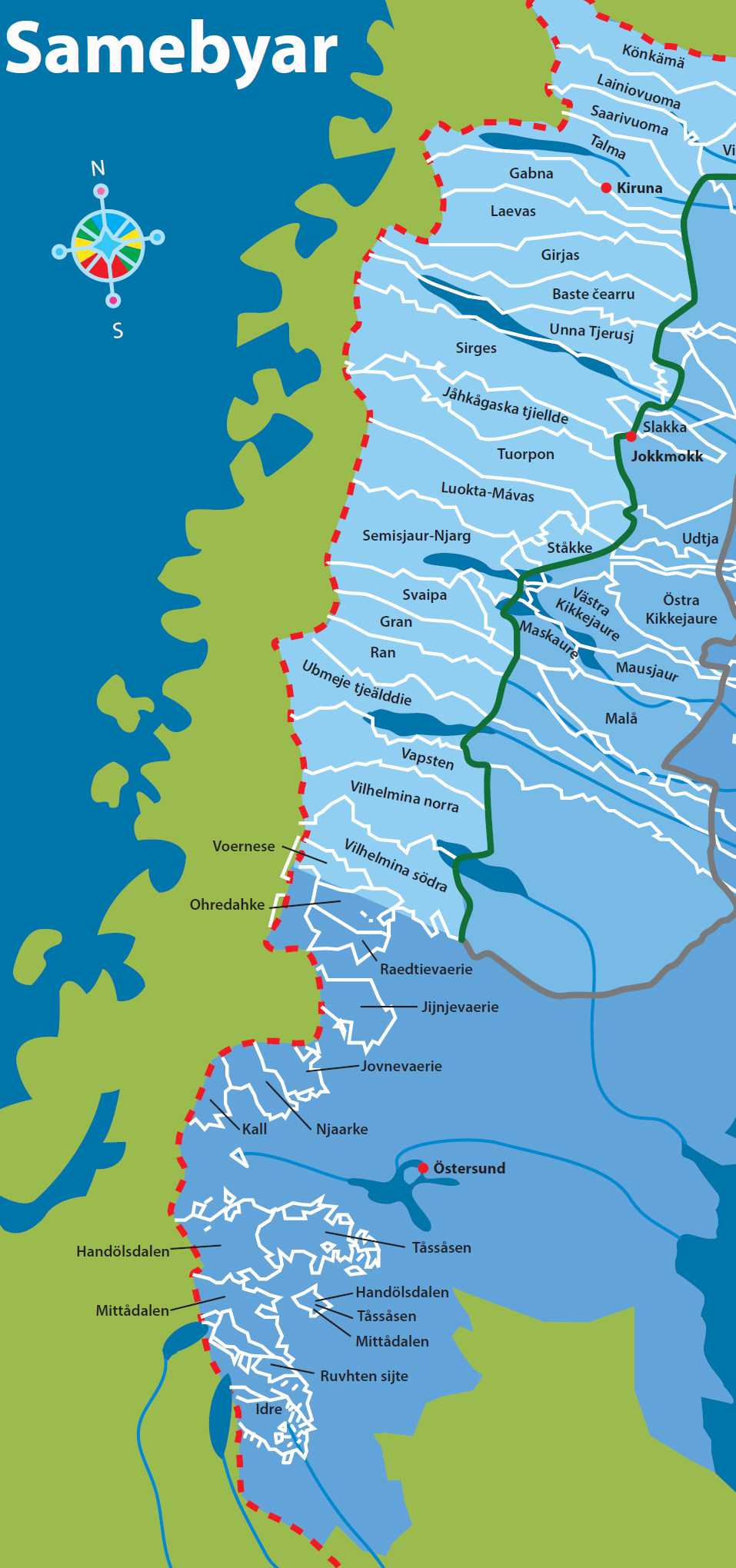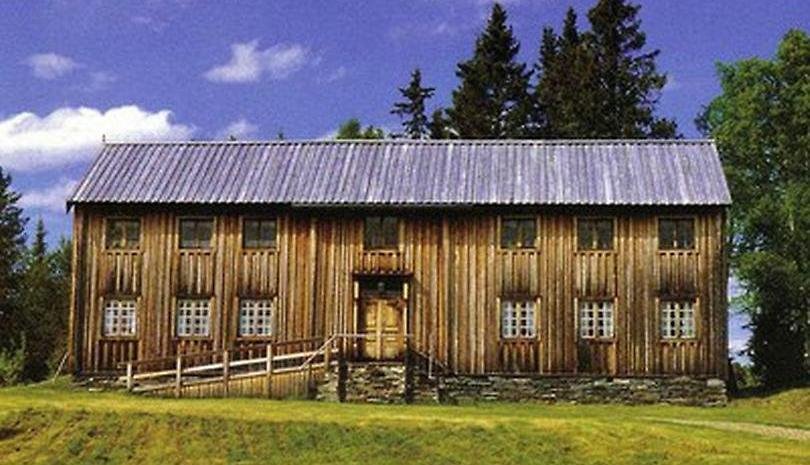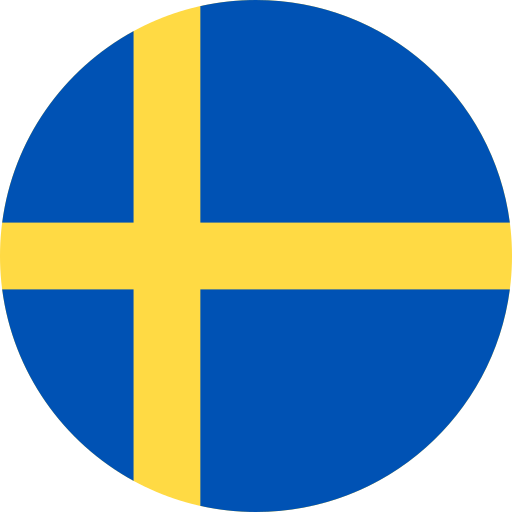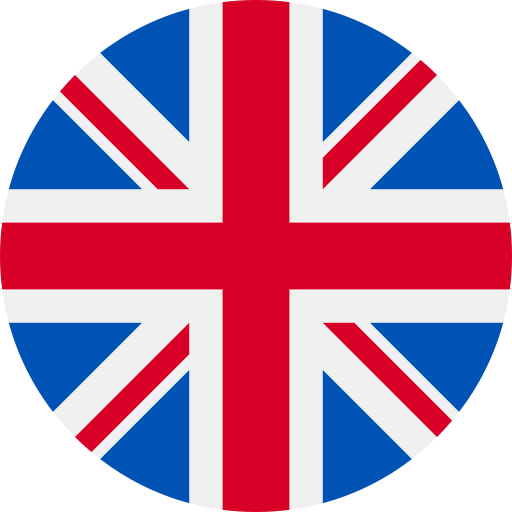Culture
In the mountain area of Frostviken, Frööstege, three cultures meet.
The Norwegian, the Swedish and the Sami.
Each one of these cultures has its own stories, its history, artistic expressions and belief systems. This has created patterns of life. Human activities that leave tracks.
Seven Sami Villages
The land of the indigenous Sami is really without actual borders. These have been imposed upon the Sami people later and has forced them into various nation states: Russia, Finland, Sweden and Norway. Their area is called Sápmi.
Sápmi contains the whole northern part of the Arctic, the Russian Kola peninsula in the east to the Swedish province of Dalarna in the south. The Sami are one of the world's indigenous peoples, as are for example also the Native americans in the USA.


Here in Frostviken we live in close proximity to seven Sami villages that work with reindeer. They inhabit areas on both the Swedish and the Norwegian sides.
Swedish side of the border
Voernese sameby (Frostviken's northern sami village)
Ohredahke sameby (Frostviken's middle sami village)
Raedtievaerie sameby (Frostviken's southern sami village)
Jiingevaerie sameby (Hotagen's sami village)
Norwegian side of the border
Skæhkeren sijte (Skjækerfjell reindeer herding area/sami village)
Låarten sijte (Luru reindeer herding area/sami village)
Tjåehkere sijte (East Namdal reindeer herding area/sami village)
Sörsami museum and cultural centre in Snåsa. Saemiensitje
Postcard Exhibition
In the hotel hallway we present an exhibition of postcards with Sami motives that tourists to Sapmi sent home nearly 100 years ago. To this day, contact with Sami culture is important for visitors. In many cases, the postcard image still present a near accurate description of Sami culture today. We can learn much from the indigenous Sami people and their ancient knowledge and culture.
The postcard collection tells the story of Sami life through the pictures they present. They date back to the 1900's. It is interesting to note that the cards were sent from various northern mountain localities and mainly to women. Most appear to have been visitors enjoying the beautiful scenery and wilderness, but with a strong interest in Sami culture. We get a glimpse of both authentic everyday images of Sápmi from different eras, and also more worked, or created, images as decorative postcards. The design of the postcards and the amount of text they contain has definitely changed over the years.
The exhibition comprises a selection of postcards with Sami motifs that Pilgrimshotellet has in its collection of about 700 postcards. The images present a picture of Sami's culture from the late 1800's and onwards, and give thought to those who sent and read them. We present 14 triptychs on different themes. There are an additional 4 triptychs as well as 3 paintings and a number of plain postcards that are also included in the exhibition.
5 Churches and Chapels
The area has 5 lovely churches & chapels that are well worth a visit. They were constructed from the 18th century to the 20th century. Several of them are characterized by the local mountains and the people who lived here. People from Sami, Swedish and Norwegian origins.
Read more about the 5 churches, "Vikens Kapell" chapel, "Tunnsjö Kapell" chapel, "Ankarede Kapell" chapel, "Sjoutnäs Kapell" chapel and "Gäddede Kyrka" church.
The 5 churches
Ankarede - ångkerenjeeruve
Ankarede is the only preserved church town in the county of Jämtland. It's one of three living sami church villages in Sweden. Another one is Fatomakke that's also located along the Wilderness Road. Ankarede has old heritages like an old church and burial site. We don't know exactly how old it is. According to sami tradition the burial site in Ankarede was there long before the settlers came to Frostviken.
The sami name is Ångkerenjeeruve, åanghkere johke - a river that has many deep holes. Njeeruve - a dried up and overgrown bank that generally is flooded during springtime. Nearby Ankarede, Lejarälven and Ankarälven (rivers) has their outlets in the lake of Stora Blåsjön. The sami name runs back to the time before we started controlling the water flow. The sami settlement consists of around thirty church cots and a few wooden storehouses. Frostviken-Hotagen sami association have had their compound here since 1927.
Ångkerenjeeruve
Brochure sami cultural areas
Frostviken - Frööstege
There are several settlements from the stoneage in the area suggest that there has been older hunting and collecting culture here. Many of these places are now closed up. There are also a large amount of trapping pits. In a few places there are also prehistoric graves, where findings from the Vikings were discovered.
The settlers came with the first permanent resident in Frostviken who moved in from Nordli in Norway to the current village Frostviksbränna around 1750. The border between Sweden and Norway was decided around Strömstad in 1751. In the negotiations Norway and Denmark had some demands on Frostviken, since a large part of the area was integrated with Norway. Hence the "gash" in the map which means that Lierne in the west remained norwegian.
In Frostviken there were significant deposits of soapstone, which were transported down to Strömsund for processing from the 1910s to the 1940s. It was mainly gravel, flour and plates for use in various industrial processes. Mica used in the electrical industry was mined in the area around Väktarmon, 20 kms north of Gäddede, in the 1940s. Previously, other minerals have also been mined in several places within the parish.
After this, hydroelectric power was expanded and the forestry industry began to grow. All of this contributed to an increase in the population of the area. Even tourism found its way here, from the beginning of the 20th century. Already in 1925, Gäddede tourism hotel, now Pilgrimshotellet, was constructed, but in a different building to the current one.
Gäddede - Tjeedtege
Gäddede is situated in a mountain area only 5 kms east of the border with Lierne in Norway. The town has slightly less than 500 inhabitants between the lakes Kvarnbergsvattnet in the north and Hetögögeln in the south, both of which are part of the lake system Ströms Vattudal. At the Kvarnberg waterfront beach at the top of Ströms Vattudal, the hotel Pilgrimshotellet is beautifully situated on the lake front. In Gäddede town you will find most services you need and it is a good idea to stock up on supplies here for explorations in the surrounding wilderness.
There is also a Tourism Office with a Nature Room. They can provide you with most of the information you might need. There is also a mountain park nearby that shows off the local fauna. The cultural heritage centre, or Hembygdsgård, in Gäddede is an attraction which has a café and a museum. It is usually open from Midsummer until the first week of August. Here there are at least 3,000 objects, with mainly tools used by the peasants. Within the museum area there are also a number of very rare and noteworthy buildings. The area is connected to Gärdet which is suitable for easier walks.
Dr hummel 1893-1984
Dr Hummel was active as a research traveler, doctor and member of the resistance. As a doctor and member of the last of Sven Hedin's famous expeditions, he was also a personal friend of Hedin's. After the Hedin expedition he became a doctor in the then called Frostviken's municipality, nowadays Strömsunds kommun, and stationed in Gäddede on the Norwegian border in 1932-1956. Hummel benefited from his friendship with Hedin during World War II, when he as a resistance man helped Norwegians to flee across the border and conveyed important information to the resistance.
Hedin was himself a personal friend of Hitler, so it is likely that the Germans in Norway were a little afraid of doing anything wrong against Hummel. He was part of a large network of couriers and assistants ranging from the Norwegian Embassy in Stockholm to many different resistance groups spread throughout Norway. Hummel had a favorable location in his hometown of Gäddede, close to the Norwegian border. For his efforts, he received the Commander's honour of St. Olav's Order and the White Rose of Finland in 1946. The motivation for the honour of St. Olavsorden stated: "for particularly excellent merits of Norway's cause during the war". His name was also given to a street in Namsos, Dr. Hummels veg.
As a doctor, he also made great efforts to improve public health. Hummel provided a district nurse to the municipality, vaccinated against tuberculosis, isolated people with illnesses, and convinced the municipality to build a bathing hall.
Hummel continued to visit Frostviken and Gäddede even after his retirement. There he stayed in his summer house by Hembygdsgården, or Cultural heritage centre, of which association he was the founder in 1935. In 2006, David Hummel gave name to a road in Gäddede called Dr. Hummel's väg.

Flyktingloppet
The refugee race is a skiing contest in memory of those who fled from Norway to Sweden during World War II. The motto of the competition is therefore: "IN THE TRACKS OF THE REFUGEE FOR FREEDOM AND PEACE".
It is a unique race of 12, 18 or 42 kms, arranged for the 65th time in 2015. The race was arranged for the first time in 1950 and has been an annual event since then, only canceled once (in 1982). The race starts in Nordli in Norway And finishes in Gäddede, Sweden, and mainly follows the way the refugees took during the war. The race is organised in collaboration between Lierne IL and Gäddede SK (sport clubs). The competition is therefore unique as it started and maintains the Swedish-Norwegian network and link that was so important during the war years.
Flyktingloppet

